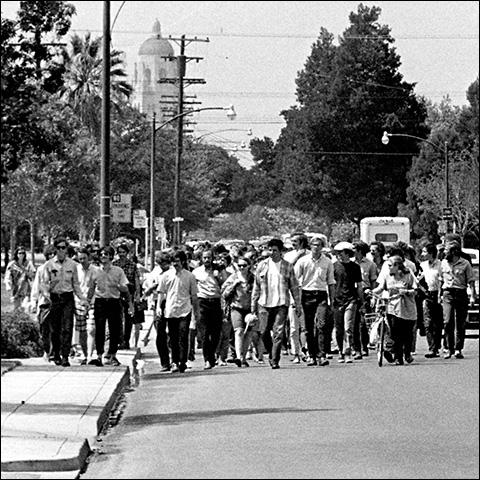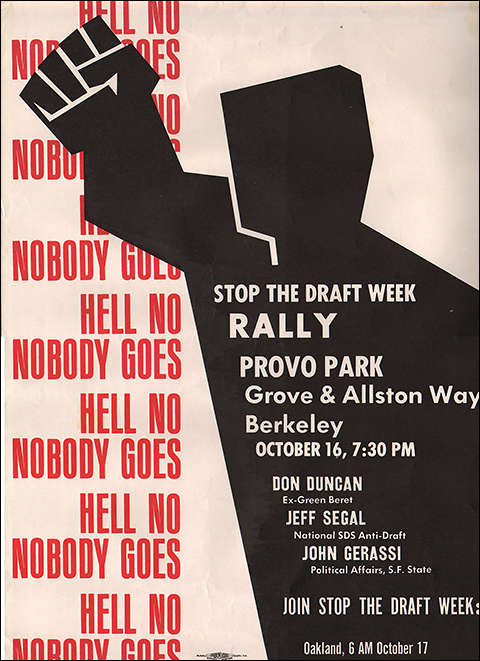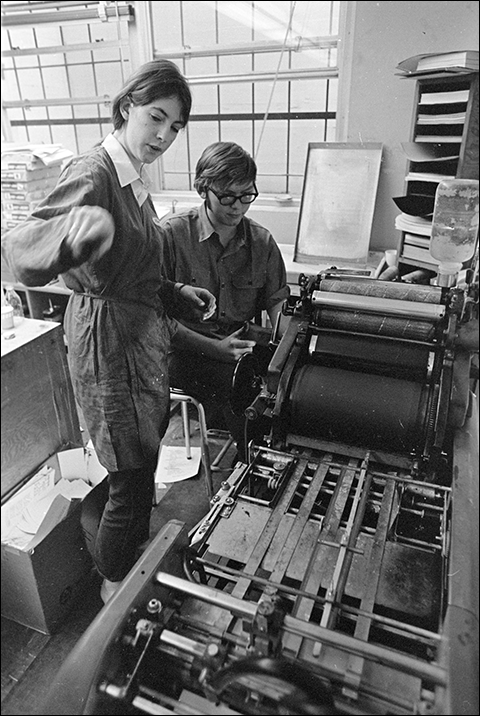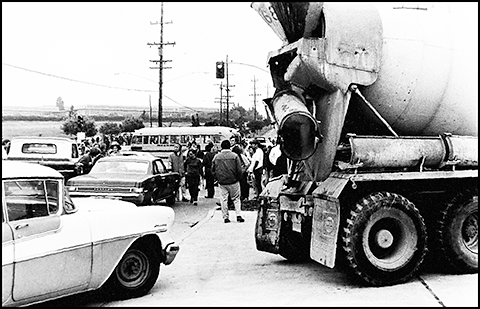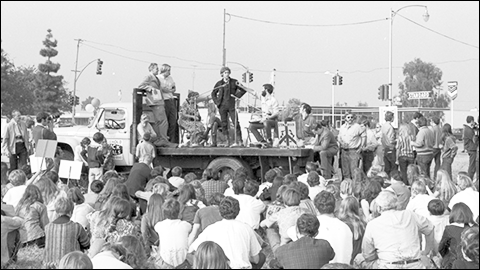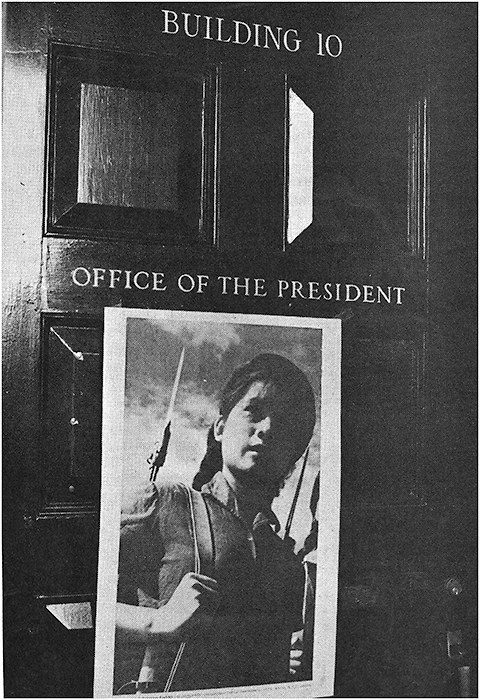Graphics Credits
Graphics
At a time when the average person may take dozens, if not hundreds of high-quality photos every week, it’s hard to imagine the paucity of reproducible photographic images from 50 years ago. So I’m particularly thankful to the Stanford Historical Society, the Stanford University Archives, and the Stanford News Service for retaining and making available most of the images in Disturbing the War, as well as the Movement photographers who held on to their pictures.
Lenny Siegel
Many photographs shown in Disturbing The War have been provided courtesy of Stanford University where they are archived in various photographic collections and made available in the Stanford Digital Repository under the auspices of Stanford Libraries, Department of Special Collections & University Archives, Stanford University, Stanford, California.
Many other photographs and graphics are from the A3M Historical Archive, located on the April Third Movement Web site.
All the photos and images in this book have been reprinted with permission from the creators or institutions that provided them.
Cover
Photo by Stanford News Service
Lenny Siegel leads a march to the Stanford Research Institute's counterinsurgency offices, April 21, 1969.
SDS March through Industrial Center Park, Stanford News Service Records, News Service #7093-9, April 21, 1969. Copyright © The Board of Trustees of the Leland Stanford Junior University. All rights reserved.
Clck on the image for a larger view.
Fig. 2.1 (Page 19)
Photo by Jeff Kane
October 16, 1965 peace march to Palo Alto. Notice the men wearing ties.
Clck on the image for a larger view.
Fig. 2.2 (Page 22)

Photo by Leo Holub
Stanford’s first sit-in, May 19-21, 1966, in President Sterling’s office protested university complicity with the Selective Service System (SSS).
Student sit-in protesting Selective Service testing, J. E. Wallace Sterling, President of Stanford University, Papers, May 20, 1966. Copyright © The Board of Trustees of the Leland Stanford Junior University. All rights reserved.
Fig. 2.3 (Page 23)

Stanford students’ effort to provide medical aid to Vietnam drew the unfriendly attention of Congress, November 2, 1965.
Rally-blood pledging for Vietnam, Stanford News Service Records, News Service #3404-11, November 2, 1965. Copyright © The Board of Trustees of the Leland Stanford Junior University. All rights reserved.
Fig. 2.4 (Page 31)
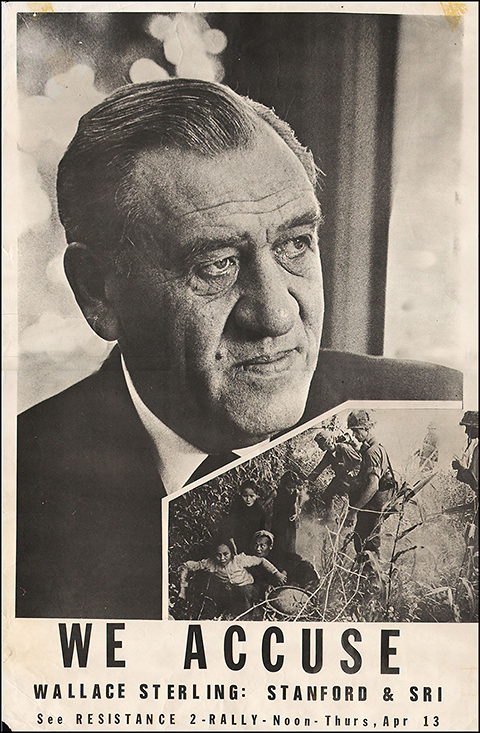
One of four
We Accuseposters plastered around campus in April, 1967. The author still is looking for clean versions of posters featuring Ernest Arbuckle (SRI and Stanford Business School); Trustees Hewlett and Packard; and Trustees Ducommun and Lewis.
Fig. 3.1 (Page 39)

Photo by Chuck Painter
Resistance leaders David Harris and Paul Rupert burn draft documents in White Plaza, November 14, 1968.
Student demonstrations, Stanford Historical Photograph Collection, SHPC Photo ID 8983, November 14, 1968.
Fig. 3.2 (Page 42)
First poster promoting October, 1967 demonstrations at the Oakland Induction Center.
Clck on the image for a larger view.
Endorsed by: SNCC, National Mobilization—Draft Resistance Project, THE MOVEMENT (SNCC-affiliated newspaper). Oakland Peace and Freedom Center, Oakland Direct Action Committee, THE SPOKESMAN (Hunters Point community newspaper), Alliance for Black Unity, Berkeley Anti-Draft Union, The Resistance, S.F. Draft Resistance Union, United Student Movement (high school), June 23 Movement, L.A. Draft Resistance Union, L.A. Black Anti-Draft Union, Freedom Draft Movement, L.A. SDS, Portland Draft Resistance Union, Seattle Draft Resistance Union, and National Students for a Democratic Society.
Fig. 3.3 (Page 43)
Second poster promoting October, 1967 demonstrations at the Oakland Induction Center.
Clck on the image for a larger view.
Fig. 4.1 (Page 64)

Photo by Chuck Painter
May 6, 1968 mass meeting in the Old Union courtyard during the sit-in protesting the suspension of anti-CIA demonstrators.
May 6, 1968 Demonstration, Stanford News Library, Stanford University, Stanford, California.
Fig. 5.1 (Page 77)

With a gold-painted spike, SDS nailed its demand that Stanford Get Out of Southeast Asia to the Board of Trustees’ office door, October 8, 1968.
Fig. 5.2 (Page 80)
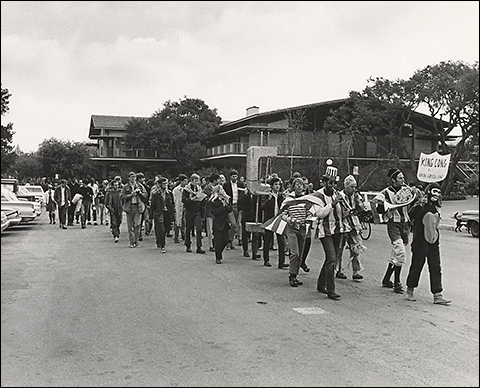
Photo by Chuck Painter
SDS marches to the Applied Electronics Laboratory, election day, November 5, 1968, to exorcise the building.
Student demonstrations — April Third Movement — Applied Electronics Lab, Stanford Historical Photograph Collection, SHPC Photo ID 9438, November 5, 1968.
Fig. 5.3 (Page 86)
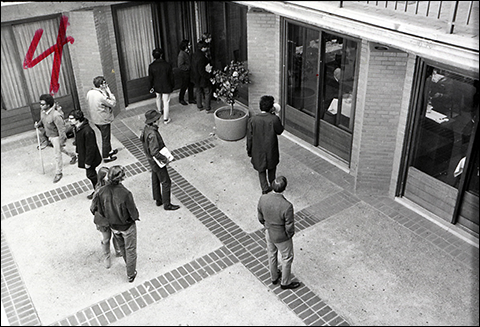
Lenny read the SDS demands to the trustees. This is what ended his academic career.
Student demonstration, Photo by Stanford News Service, Stanford News Service Records, January 14, 1969.
Fig. 5.4 (Page 87)

Photo by Stanford News Service
As demonstrators forced their way into the Trustees’ lunchroom, Lenny was sandwiched among Presidential Assistant Fred Glover, Dean of Students Joel Smith, and News Service head Bob Beyers.
Student demonstration, Stanford News Service Records, January 14, 1969.
Fig. 5.5 (Page 88)

Photo by Stanford New Service
Inside the Trustees’ lunchroom at the Faculty Club. The student to Lenny's right was the one who identified himself as Emiliano Zapata.
Student demonstration, Stanford News Service Records, January 14, 1969.
Fig. 5.6 (Page 89)
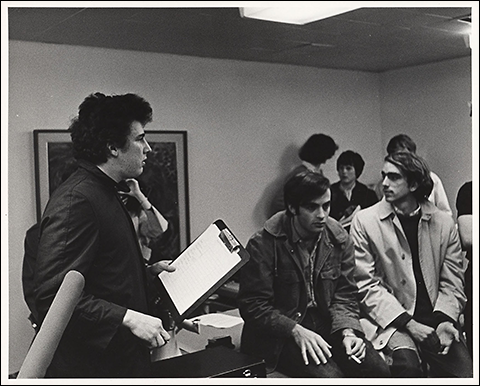
SDS entered President Pitzer’s office on January 28, 1969 to invite him to a rally the following day. Characteristically, I was holding a clipboard.
Student demonstrations — Students for a Democratic Society, Stanford Historical Photograph Collection, SHPC Photo ID 11238.
Fig. 5.7 (Page 92)
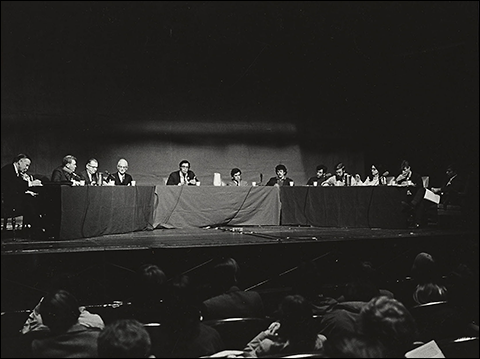
The March 11, 1969 student-trustee forum in Memorial Auditorium was a turning point for the Stanford Movement.
Written on back of photo:
trustees meet with students in Memorial Aud.and
Trustees: L. to R.: 1. Charles Ducommon, 2. (Obscured), 3. Bill Hewlett, 4. W. Palmer Fuller, III, 5. Ben Duniway.
Student demonstrations — April Third Movement — Encina and Trustees meet students, Stanford Historical Photograph Collection, SHPC Photo ID 9451.
Fig. 6.1 (Page 102)
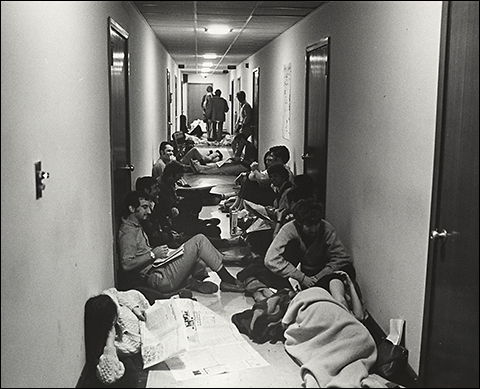
The AEL Hallway. This is what democracy looks like.
Sit-in at Applied Electronics Laboratory (AEL), Stanford News Service Records, April 10, 1969. Copyright © The Board of Trustees of the Leland Stanford Junior University. All rights reserved.
Fig. 6.2 (Page 103)

At AEL, the Movement made its decisions in public.
Student demonstrations — April Third Movement — Applied Electronics Lab, Stanford Historical Photograph Collection, SHPC Photo ID 9441.
Fig. 6.3 (Page 106)
Photo by Steve Rees
Small-group discussion in the AEL Courtyard. The man with his hands in his pockets is FBI informer Thomas Mosher. Copyright © 2016 by Steve Rees.
Clck on the image for a larger view.
Link: To see additional photos of the movements of the sixties,
go to Music + Mayhem (www.sixties-photos.com).
go to Music + Mayhem (www.sixties-photos.com).
Fig. 6.4 (Page 110)
Photo by Steve Rees
April, 1969. A key feature of the AEL sit-in was our round-the-clock operation of the building’s print shop. Copyright © 2016 by Steve Rees.
Clck on the image for a larger view.
Link: To see additional photos of the movements of the sixties,
go to Music + Mayhem (www.sixties-photos.com).
go to Music + Mayhem (www.sixties-photos.com).
Fig. 6.5 (Page 114)

Photo by Stanford News Service.
Mass meeting of student body, April 18, 1969, the day the April Third Movement left AEL.
Student body meeting — Frost Amphitheater, Stanford News Service Records, News Service #7075-2, Created April 18, 1969. Copyright © The Board of Trustees of the Leland Stanford Junior University. All rights reserved.
Fig. 6.6 (Page 133)
It didn’t make headlines, but much of the Movement’s activity consisted of people sitting in circles, talking, listening, and thinking. This may have been the affinity group to which Lenny belonged, the David Starr Jordan Anti-Imperalist League, at the May 12, 1969 A3M Carnival. Lenny is the one with sunglasses on his head.
Clck on the image for larger view
Fig. 6.7 (Page 135)
One of our April Third Movement affinity groups built a plywood Geodesic Dome on “Agitators’ Grass” in White Plaza, May 12, 1969.
Clck on the image for a larger view.
Fig. 6.8 (Page 137)
A determined A3M Affinity Group marches up Hanover Street toward SRI’s Counterinsurgency Offices. May 16, 1969.
Clck on the image for a larger view.
Fig. 6.9 (Page 138)

Photo by Stanford News Service
Motorists avoid the A3M blockade at Hanover and Page Mill. Hewlett-Packard stands in the background.
April 3rd Movement demonstration at SRI, Stanford News Service Records, News Service #7194-2, May 16, 1969. Copyright © The Board of Trustees of the Leland Stanford Junior University. All rights reserved.
Fig. 6.10 (Page 140)
Demonstrators let this concrete truck pass when the driver said the concrete would harden, Hanover and Page Mill, May 16, 1969.
Clck on the image for a larger view.
Fig. 6.11 (Page 141)
May 16, 1969 demonstration that for a day closed down SRI’s counterinsurgency offices at Hanover and Page Mill.
Clck on the image for a larger view.
Fig. 6.12 (Page 142)
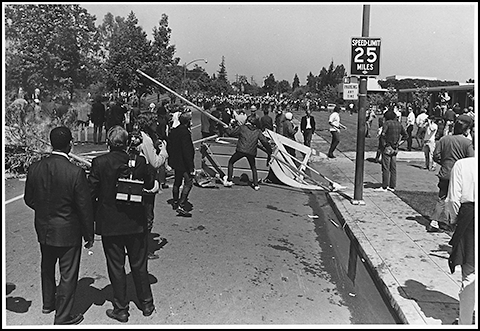
Preparing for the police sweep on Hanover Street, May 16, 1969.
Student demonstrations — April Third Movement — 1969 — SRI, Stanford Historical Photograph Collection, SHPC Photo ID 9435, May 16, 1969.
Fig. 6.13 (Page 143)
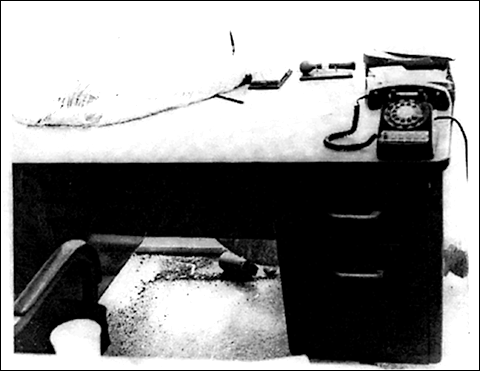
Expended tear-gas canister under desk at SRI.
Fig. 7.1 (Page 150)

Vietnam Moratorium mass meeting in Memorial Church, October 15, 1969. Linus Pauling is speaking.
Vietnam Moratorium Exercises: Linus Pauling speaks in Memorial Church,Student demonstrations — Vietnam moratorium, Stanford Historical Photograph Collection, SHPC Photo ID 11514, October 15, 1969.
Fig. 7.2 (Page 151)
Photo by Jeff Kane
Leafletting in the Industrial Park, Vietnam Moratorium, November 14, 1969.
Clck on the image for a larger view.
Fig. 7.3 (Page 152)
Photo by Jeff Kane
At a November 14, 1969 Vietnam Moratorium Rally at Hanover and Page Mill, SDS member Peter Dollinger described the military work that was underway in the Stanford Industrial Park and explained the companies’ connections with Stanford. This is virtually the same location as the SRI blockade on May 16 earlier that year.
Clck on the image for a larger view.
Fig. 7.4 (Page 153)
Design by Lenny Siegel
Lenny Siegel created this poster illustrating the military contracting and other work done in the Stanford Industrial Park, produced during the Spring, 1970 Cambodia Strike. In 2016 Lenny showed it to residents of the adjacent College Terrace neighborhood as the Movement pressured Stanford to be more protective of future residents of faculty housing being constructed on Site #1.
Click on the image for a larger view.
Fig. 7.5 (Page 158)

Grass Roots protests Palo Alto Square development, January 12, 1970.
Student demonstrations, Stanford Historical Photograph Collection, SHPC Photo ID 8980, 1970.
Fig. 7.6 (Page 166)

Cover photo from Chaparral magazine, February 16, 1970
Fig. 7.7 (Page 169)
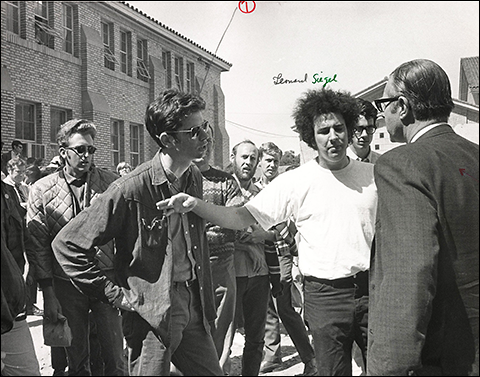
Siegel and other Off ROTC protesters confront Stanford
policechief William Wullschleger.
Student demonstrations, Stanford Student Demonstrations Collection, 1970. Copyright © The Board of Trustees of the Leland Stanford Junior University. All rights reserved.
Fig. 7.8 (Page 171)
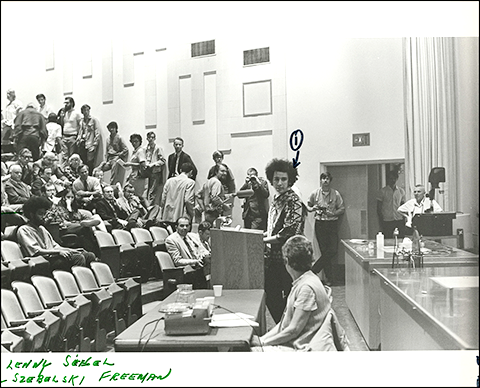
On April 3, 1970, Lenny Siegel
rudely and illegallytried to call to order a meeting of Stanford’s faculty, the Academic Council. He spent five days in jail for the exercise. The scrawled number is part of Stanford’s systematic use of photography to identify and punish protesters.
Student demonstrations, Stanford Student Demonstrations Collection, 1970. Copyright © The Board of Trustees of the Leland Stanford Junior University. All rights reserved.
Fig. 7.9 (Page 179)
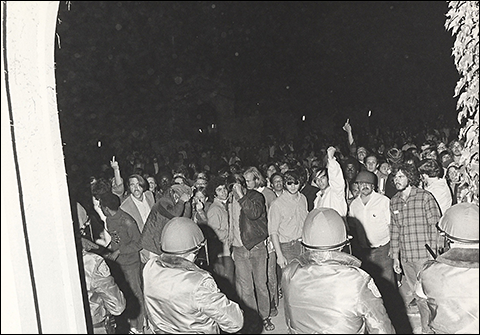
Police guard the Old Union after expelling and arresting “Off ROTC” protesters, April 29 or early morning of April 30, 1970.
Photo donated by Donald T. Carlson. Student demonstrations — strike — 1970, Stanford Historical Photograph Collection, SHPC Photo ID 6782, April, 1970.
Fig. 7.10 (Page 181)

April 29 or 30, 1970. Police attempt to clear protesting students from White Plaza.
Photo donated by Donald T. Carlson. Student demonstrations — strike — 1970, Stanford Historical Photograph Collection, SHPC Photo ID 6799, April, 1970.
Fig. 7.11 (Page 184)
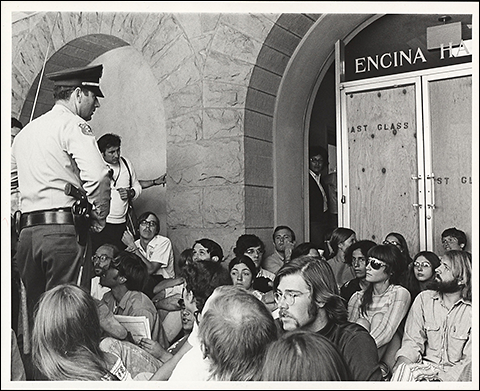
Students blockade the main administration building, Encina Hall, during the Cambodia strike, May, 1970. Notice the plywood windows.
Student demonstrations — strike — 1970, Stanford Historical Photograph Collection, SHPC Photo ID 6809.
Fig. 7.12 (Page 188)

Durand
Aero and AstroBuilding during Cambodia Strike, May, 1970. Notice the windows. Another photo of Durand appeared in fall, 1970 Fire and Sandstone with the caption, “People who work in glass buildings should not do war research.”
Student demonstrations — strike — 1970, Stanford Historical Photograph Collection, SHPC Photo ID 6817, 1970.
Fig. 7.13 (Page 190)
Design by Leif Erickson
Poster produced during the Cambodia Strike.
Clck on the image for a larger view.
Fig. 7.14 (Page 191)
Design by Leif Erickson
Perhaps the best of many representations of the corporate connections of the Stanford Board of Trustees, produced during the Cambodia Strike.
Clck on the image for a larger view.
Fig. 7.15 (Page 192)

Photo by Chuck Painter
Cambodia Strike at the Graduate School of Business, one of the campus’s most conservative enclaves. May, 1970.
Student demonstrations — strike — 1970, Stanford Historical Photograph Collection, SHPC Photo ID 6814, May 05, 1970.
Fig. 8.1 (Page 203)
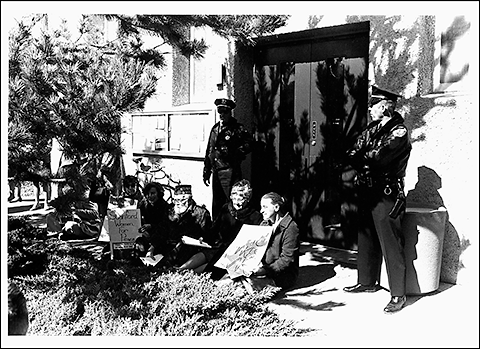
Protesting FMC recruiting.
Picketing FMC recruiting at placement center, Stanford University News Service Records, News Service #8529-5, February 26, 1971. Copyright © The Board of Trustees of the Leland Stanford Junior University. All rights reserved.
Fig. 8.2 (Page 205)
This photo appeared on the back cover of Fire and Sandstone, Fall 1970. It was probably taken during the Spring 1970 Cambodia Strike.
Clck on the image for a larger view.
Fig. 8.3 (Page 214)

Audience at January 12, 1971 Lodge protest. “Where’s Bruce?” How did Hoover’s Berkeley Tomkins spot Bruce Franklin in this crowd?
Demonstration against Ambassador Lodge, Stanford News Service Records, News Service #8431-15, January 11, 1971. Copyright © The Board of Trustees of the Leland Stanford Junior University. All rights reserved.
Fig. 8.4 (Page 215)

Photo by Jose Mercado
Protesting SRI’s war gaming program, Gamut-H, at the University Computation Center, February 10, 1971.
Student demonstrations — Computation Center, Stanford Historical Photograph Collection, SHPC Photo ID 9456, February 10, 1971.
Fig. 8.5 (Page 216)
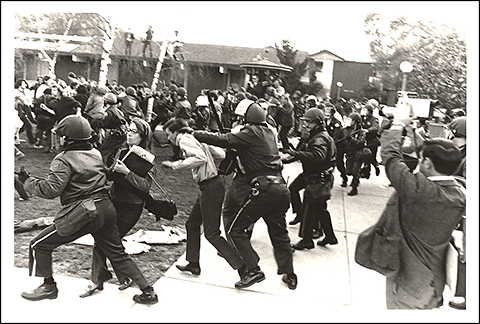
Photo by Chuck Painter
Police rout peaceful demonstrators from the area around the Computation Center after the occupation ended. Professor Bruce Franklin was fired, in part, for arguing with the police that the dispersal order was unjustified and illegal. February 10, 1971.
Student demonstrations — Computation Center, Stanford Historical Photograph Collection, SHPC Photo ID 9458.2, February 10, 1971.
Fig. 9.1 (Page 244)
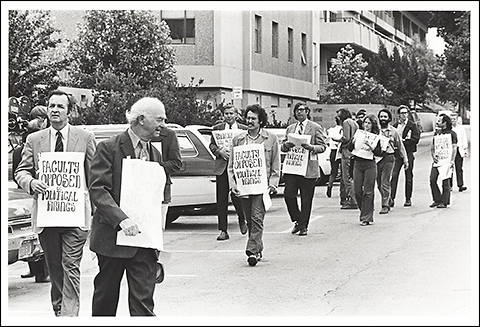
Professors protest the prosecution of Bruce Franklin. Two-time Nobel Laureate Linus Pauling is wearing a home-made sign, “Try Lodge, Not Franklin.” September 29, 1971.
Student demonstrations — Franklin, H. Bruce — dismissal, Stanford Historical Photograph Collection, SHPC Photo ID 3276, September 29, 1971.
Fig. 9.2 (Page 254)

Photo by Stanford News Service
Students marching from White Plaza to El Camino Real in protest of Nixon’s escalation of the War, April 21, 1972.
Campus protest against war in Vietnam, Stanford News Service Records, News Service #9359-3, April 21, 1972. Copyright © The Board of Trustees of the Leland Stanford Junior University. All rights reserved.
Fig. 10.1 (Page 269)

The Movement never even threatened to tear down the Applied Electronics Laboratory, but at some time between 1989 and 1999 the university administration wiped it off the map.
Fig. 10.2 (Page 278)
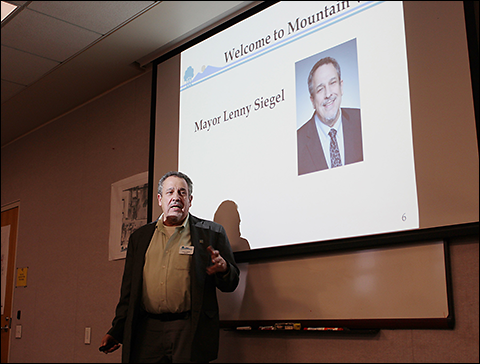
Lenny Siegel was elected to the nearby Mountain View City Council in 2014 on some of the housing and land use issues that he worked on at Stanford in 1969-70. It was his turn to become mayor in 2018.
